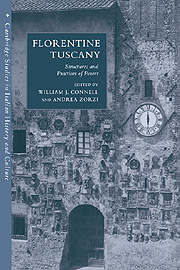Book contents
- Frontmatter
- Contents
- List of figures
- List of tables
- List of abbreviations of archival sources
- Introduction
- 1 The ‘material constitution’ of the Florentine dominion
- 2 The language of empire
- 3 Constitutional ambitions, legal realities and the Florentine state
- 4 Fiscality, politics and dominion in Florentine Tuscany at the end of the middle ages
- 5 Market structures
- 6 State-building, church reform and the politics of legitimacy in Florence, 1375–1460
- 7 The humanist citizen as provincial governor
- 8 Territorial offices and officeholders
- 9 Demography and the politics of fiscality
- 10 Florentines and the communities of the territorial state
- 11 Patronage and its role in government: the Florentine patriciate and Volterra
- 12 San Miniato al Tedesco: the evolution of the political class
- 13 The social classes of Colle Valdelsa and the formation of the dominion (fourteenth–sixteenth centuries)
- 14 Arezzo, the Medici and the Florentine regime
- 15 Rubrics and requests: statutory division and supra-communal clientage in Pistoia
- 16 A comment
- Index
- CAMBRIDGE STUDIES IN ITALIAN HISTORY AND CULTURE
9 - Demography and the politics of fiscality
Published online by Cambridge University Press: 16 September 2009
- Frontmatter
- Contents
- List of figures
- List of tables
- List of abbreviations of archival sources
- Introduction
- 1 The ‘material constitution’ of the Florentine dominion
- 2 The language of empire
- 3 Constitutional ambitions, legal realities and the Florentine state
- 4 Fiscality, politics and dominion in Florentine Tuscany at the end of the middle ages
- 5 Market structures
- 6 State-building, church reform and the politics of legitimacy in Florence, 1375–1460
- 7 The humanist citizen as provincial governor
- 8 Territorial offices and officeholders
- 9 Demography and the politics of fiscality
- 10 Florentines and the communities of the territorial state
- 11 Patronage and its role in government: the Florentine patriciate and Volterra
- 12 San Miniato al Tedesco: the evolution of the political class
- 13 The social classes of Colle Valdelsa and the formation of the dominion (fourteenth–sixteenth centuries)
- 14 Arezzo, the Medici and the Florentine regime
- 15 Rubrics and requests: statutory division and supra-communal clientage in Pistoia
- 16 A comment
- Index
- CAMBRIDGE STUDIES IN ITALIAN HISTORY AND CULTURE
Summary
Whether material conditions improved for the peasantry after the Black Death and into the fifteenth century remains an open question, not only for late medieval and Renaissance Florence, but for all of Europe. Historians of a Malthusian bent have seen an economic golden age for the peasantry following in the wake of fourteenth-century pestilence. From radically opposed perspectives, other historians such as the Marxist Guy Bois and the non-Marxist David Herlihy have also found prosperity for the peasantry at least in parts of Europe and for a portion of the fifteenth century. However, more recently still other historians with various methods and political agendas have argued the opposite: the fifteenth century saw at best continued misery, not recovery, for the Florentine peasantry.
Yet, despite differences in political and methodological orientations, historians have posed these questions almost exclusively within the contexts of long-term social and economic causes; the affairs of state or politics more generally, especially at the level of specific events, largely have been left out. Was the condition of the Florentine peasantry during the Renaissance oblivious to changes in political regime - to the rise of the Albizzi's govero stretto in 1393 or the rise of the Medici in 1434? Or, did other political events have long-term consequences in shaping the fortunes of Florentine peasants?
This chapter will present data from a series of tax records from twenty-nine sample villages in the rural territory or (more precisely) the contado of Florence, from the Black Death through the fifteenth century.
- Type
- Chapter
- Information
- Florentine TuscanyStructures and Practices of Power, pp. 183 - 206Publisher: Cambridge University PressPrint publication year: 2000



